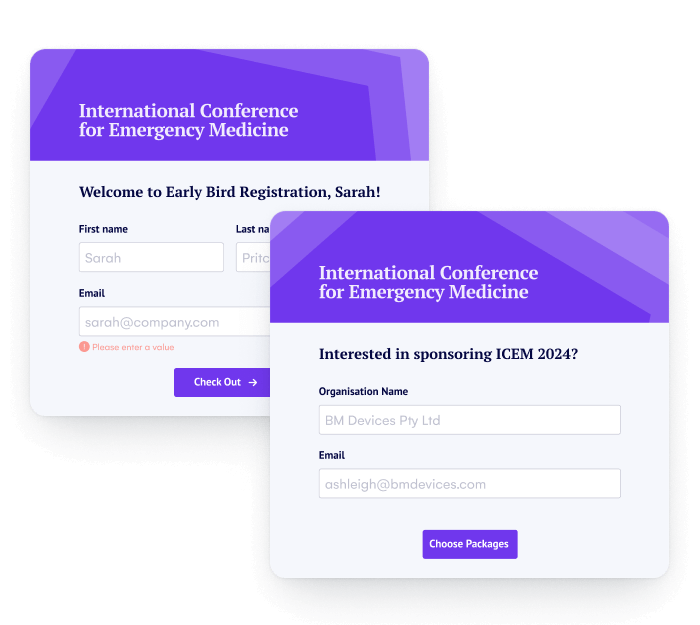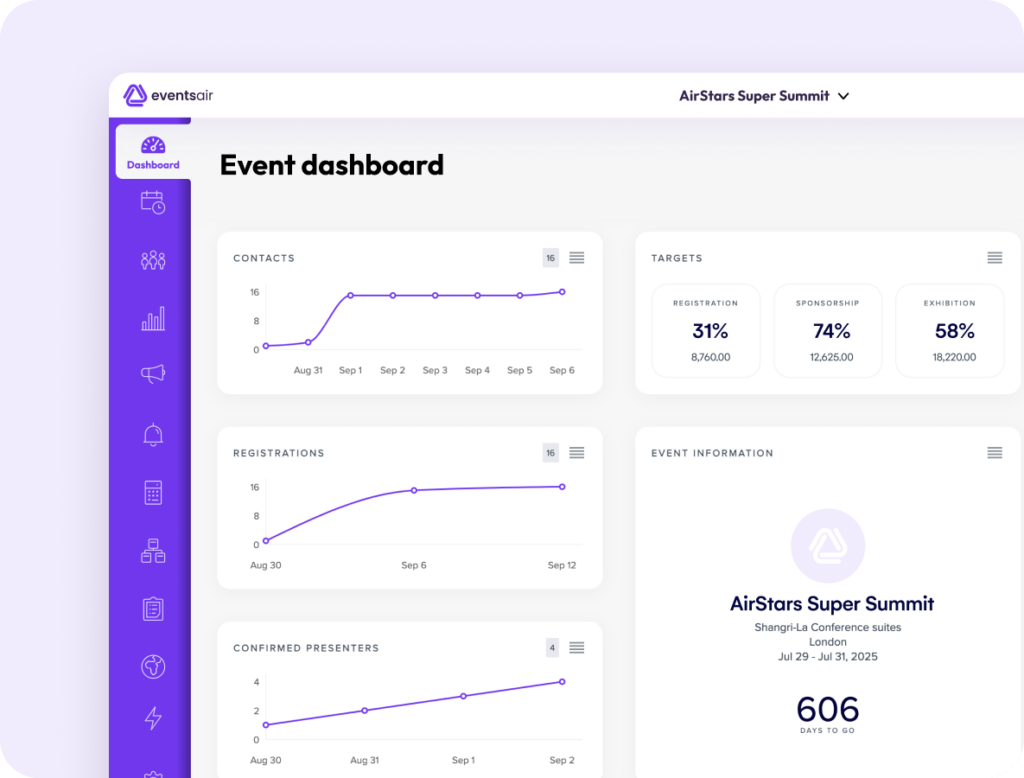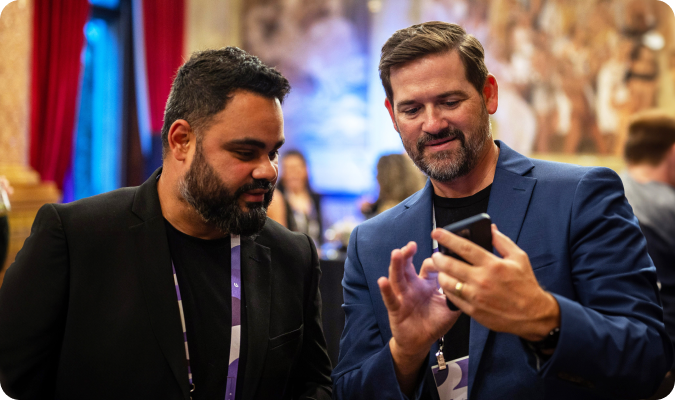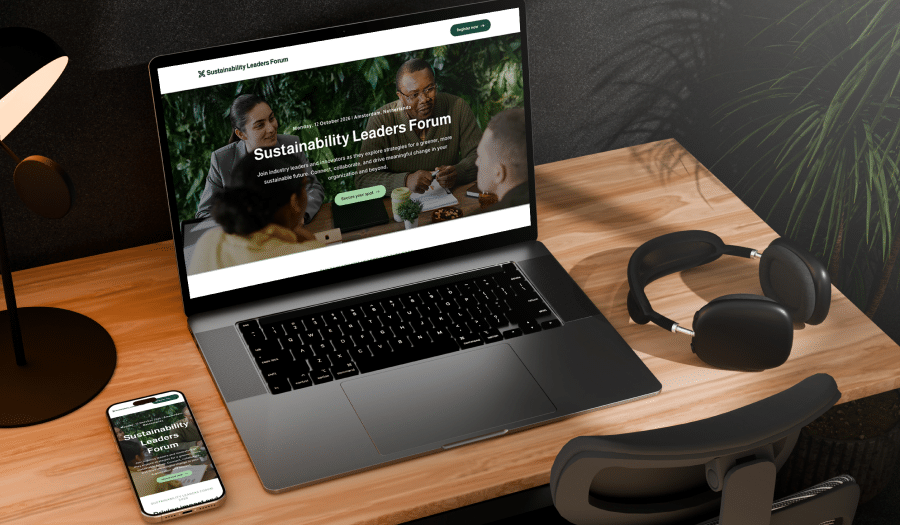
Promoting an event requires a mix of strategic planning, targeted messaging, and leveraging the right digital advertising channels. Without an effective digital advertising strategy, even the best event can miss its target audience and fail to reach attendance goals.
In this EventsAir article, we’ll walk you through how to advertise your event step-by-step, highlight useful tools, and share advanced tips for optimal reach and impact.
How to advertise your next event digitally
1. Understand your audience
Start by analyzing your existing attendee data. Look for patterns in job roles, industry segments, and past event participation. This creates your baseline audience profile.
Every potential attendee faces obstacles. Common barriers include budget constraints, time investment, competing priorities, and uncertainty about ROI. Identify which barriers affect your specific segments to guide both messaging and solutions.
Track how your audience discovers and evaluates events:
- Where they first learn about industry events
- What information do they use to assess value
- Which factors drive final registration decisions
Event management platforms like EventsAir can enrich your audience insights through historical event data, such as:

- Registration records: Detailed professional profiles and demographic information from past event attendees.
- Event engagement data: Attendance patterns and participation rates across previous sessions and activities.
- Survey results: Direct feedback from past attendees about event preferences and experiences.
- CRM records: Integrated customer data revealing long-term engagement patterns and preferences.
By analyzing these historical data points, you can build detailed audience segments and create targeted value propositions based on actual behavior patterns – not assumptions.
2. Build your campaign timeline
Start with your event date and work backward. Most successful events need at least three months of active promotion, with high-profile conferences requiring six months or more. Your timeline should account for three key booking patterns:
- Early birds (3+ months out) seeking maximum value
- Main wave (1-3 months out) planning ahead
- Last-minute (final month) waiting for certainty
Consider seasonal factors that affect your audience’s decision-making. Budget cycles, competing events, and busy industry periods all impact registration timing. B2B events often see slower responses during summer months and year-end.
Map your content to match audience readiness. Start with awareness and thought leadership, transition to specific event benefits, and end with urgency-driven messaging. Each phase should build on the previous one.
Reserve 25% of your promotional budget for last-minute pushes. Even well-planned campaigns often need final-week amplification to hit registration targets.
3. Define campaign structure (timing, goals, budget)
A clear campaign structure ensures focused, measurable advertising efforts across all channels.
Begin by setting specific goals that align with your event objectives and determining which advertising platforms you’ll use. Your campaign needs three core elements defined from the start:
- Timing: Create a promotional calendar that maps out your advertising journey. Include pre-launch activities (e.g., teaser ads), peak promotion periods (e.g., speaker announcement campaigns), and last-minute pushes (e.g., final registration ad reminders).
- Goals: Establish concrete metrics for your advertising success. Focus on specific targets like increasing early-bird registrations by 25% or reducing advertising cost per acquisition (CPA) to a set threshold.
- Budget: Break down your advertising budget by channel and activity, focusing on platforms with proven ROI. Reserve 10-15% of your budget for flexibility in adapting to new opportunities or unexpected shifts.
Track ad spending in real-time against your goals. This lets you shift resources quickly when you identify which advertising channels deliver the strongest results for your specific event and audience.
4. Set up campaign tracking & attribution
Accurate tracking and attribution are crucial for evaluating your campaign’s effectiveness. Implementing tracking tools allows you to pinpoint where your registrations originate, helping you allocate resources effectively.
There are a few ways to go about this:
- Use UTM parameters for all ad links to identify the source, medium, and campaign performance.
- Add tracking pixels to your event’s website and registration forms to monitor visitor behavior and conversions.
- Enable platform-specific tracking (e.g., Facebook Pixel or Google Analytics) to gain insights into user engagement.
5. Choose your ad channels
Select advertising channels based on your audience’s professional habits and your event goals. Different platforms excel at different types of event promotion.
| Channel | Best For… | Key Benefits |
| LinkedIn Ads | B2B events Professional conferences | Job title targeting, decision-maker reach |
| Facebook/Instagram | Consumer events Creative conferences | Large reach, strong remarketing |
| Google Search | Time-sensitive promotions Active seekers | High intent, immediate results |
| Microsoft Ads | B2B and tech events Older audiences | Lower CPC, less competition |
| TikTok | Youth events Creative industries | High engagement, viral potential |
| Google Display | Awareness campaigns Remarketing | Broad reach, lower costs |
| YouTube | Complex events Speaker showcases | Engaging format, targeting options |
| Trade Publications | Industry-specific events Niche conferences | Qualified audiences, trust factor |
Start with one primary and two supporting channels. This lets you master each platform’s nuances before expanding. Test different channel combinations to find what works best for your specific event type and audience.
By focusing your initial budget on fewer channels, you can invest meaningfully in each platform rather than spreading resources too thin. Scale up or adjust your channel mix based on performance data to maximize return on ad spend (ROAS).
6. Build custom audiences & targeting strategy
Smart audience targeting ensures your ad spend reaches the right people. Create layered audience strategies that combine multiple targeting methods.
Start with custom audiences based on your existing data. Upload past attendee lists and CRM contacts to ad platforms for direct targeting. Use these same lists to create lookalike audiences that reach similar professionals.
Layer your targeting approach:
- Demographics: Basic professional attributes like job level and industry
- Interests: Relevant topics, skills, and professional groups
- Behaviors: Event attendance patterns and content engagement
- Intent: Recent searches and website visits related to your event type
For example, if your event is located in New York and you’re targeting health professionals – you can build an audience that geo-targets health professionals in New York. From here you can layer the appropriate demographics and interests relevant to your event.
And lastly, you can also set up retargeting for website visitors who don’t complete registration. Create different messages for those who viewed specific pages – like speaker profiles or agenda details – versus those who started but abandoned registration.

Test audience segments weekly and shift the budget to what works. Using EventsAir, you can automate your audience lists and export them directly to Facebook and X (Twitter) Ads, making it easy to adjust targeting as you learn what drives registrations.
7. Design ad creative & copy
Your ad creative and copy must quickly communicate value while maintaining consistent branding across platforms. Each ad needs three elements: a clear value proposition, proof of that value, and a specific action to take.
Three core creative types drive event registrations:
- Speaker/session highlight ads featuring key experts or topics
- Social proof ads showing past attendee numbers or testimonials
- Early-bird or special offer ads with clear deadlines
Match ad formats to your event’s strengths. Use video for dynamic speaker previews, carousel ads for multiple session highlights, and single-image ads for simple deadline reminders.
Write copy that focuses on outcomes rather than features. Instead of “3 days of sessions,” try “Transform your strategy in 3 days.” Address objections in your copy – if price is a barrier, emphasize ROI.

For example, Girls in Tech’s Women in STEM Summit uses Instagram carousels to highlight specific benefits directly.
8. Launch, monitor, and optimize performance
Start with small test budgets across your chosen channels before scaling up spending. Monitor these key metrics daily during your first two weeks:
- Registration Metrics: Track cost per registration, conversion rate, and total registrations by channel. Look beyond total numbers to registration quality – are you attracting your target audience?
- Channel Performance: Compare click-through rates and engagement across platforms. High engagement but low conversions usually signals a disconnect between ads and landing page. If you have UTMs in place, you should be able to track any increases in traffic data due to your advertising too.
- Budget Pacing: Watch spend velocity against registration goals. If you’re pacing ahead of budget but behind on registrations, pause underperforming ads before testing new approaches.
Adjust your campaign based on early data. Scale up top-performing ad sets, pause those that aren’t converting, and continuously test new audience segments and messages against your winners.
Elevate event marketing with the right platform
Effective event advertising involves understanding your audience, choosing the right channels, creating engaging content, managing your budget, and monitoring performance. By following these steps, you can ensure your event reaches its attendance and engagement goals. For advanced event promotion, consider leveraging robust platforms like EventsAir.
EventsAir provides comprehensive tools for event marketing, including marketing automation, budget tracking, and real-time analytics. These features empower event organizers to create, manage, and optimize campaigns seamlessly.
Want to see EventsAir in action? Schedule a demo today.
Best Practice | Event Marketing | Uncategorized
See EventsAir in action
Discover why 12,000+ event professionals trust EventsAir to deliver effortless events, every time.




